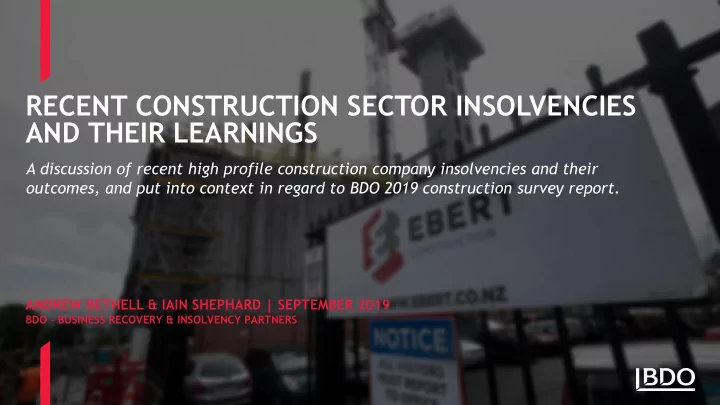

RECENT CONSTRUCTION SECTOR INSOLVENCIES AND THEIR LEARNINGS A discussion of recent high profile construction company insolvencies and their outcomes, and put into context in regard to BDO 2019 construction survey report. ANDREW BETHELL & IAIN SHEPHARD | SEPTEMBER 2019 BDO – BUSINESS RECOVERY & INSOLVENCY PARTNERS
BACKGROUND Appointed to Mainzeal in February 2013 plus 13 other companies At the time it had 40ish active projects Established good working relationship with PwC, Receuivers Sudden ceasing of projects, causing carnage amongst principals and subcontractors involved Very little in way of actions by Directors to mitigate losses prior to appointment 2
1,500 creditors, $160m of claims received At least $105m deficiency to creditors (prior to award) 2 years to investigate then issue proceedings Litigation funding secured – without which case not possible 3 more years to get to Court Millions of documents discovered and reviewed 5 law firms, 5 QCs involved (4 against our 1) 3
Many millions in legal and expert costs 1 unsuccessful mediation attempt with 40 people in the room 12 causes of action, very complex analyses on liability and quantum S135 and S136 New debt vs total creditor loss vs Mason & Lewis 4
• Standing back from the detail - it’s simple Our view - Directors clearly did not live up to standards we should • expect and should be made to compensate Mainzeal and creditors. Mainzeal was almost always unprofitable Countless quality issues Serious money advanced to related parties that could not repay Balance sheet insolvent for many years – used creditors money (retentions etc) Money went to China and they relied on money coming back Directors said Mainzeal had shareholder support, but in fact it was subsidiary support of shareholder 5
The High Court awarded $36m of damage, $2.5m against a related party and net $2.0m costs award Appealed by Directors, cross appealed by us So its been a loooong road… still going Changes to the landscape for Directors and insurers. Should it have? Not really, these Directors fell well short Board composition important 6
ARROW VS EBERT Arrow was put into Voluntary Administration in February 2019 Why a VA was opposed to other insolvency regimes? Ebert was placed into Receivership in July 2019 and Liquidation in October 2018 Compare outcomes – especially construction contract claims and orderly transition back to principals Potential outcomes and proceedings, compare Mainzeal Retentions regime – Trust Accounts Retentions – Agency contracts 7
BDO 2019 CONSTRUCTION SURVEY REPORT Second (now) annual survey undertaken by James MacQueen, BDO Auckland Report is available In 2018 there were approximately 100 respondents, in 2019 there were 216. The majority were construction companies and sub-contractors. Some material supplies and consultants. Key take out is that New Zealand has a two-tier construction industry – the haves and the have-nots The haves – strong balance sheets, good ability to provide bonds, good systems and typically a group of consistent and happy sub-contractors The have nots are, as expected, the polar opposites. Moreover, they are typically slow to be paid and slow to pay. 8
Forward work pipeline is decreasing across the board – in 2019 17% of respondents needed more work, up from 6% in 2018 The availability of sufficient and suitable staff remains an issue – true of much of New Zealand and not just construction Bureaucracy from both local and national government is pushing out timeframes and adding significantly to costs Increasing pressure on margins – not really a surprise 9
RECENT HIGH PROFILE CONSTRUCTION INDUSTRY COLLAPSES Respondents are undertaking more rigorous due diligence on both clients and sub-contractors. There is more robust contract negotiation, and more open book negotiations with agreed margins. Respondents are relying on existing long term relationships, as well as becoming more selective in all areas, clients and sub-contractors. This reinforces the haves and have-nots. 10
RETENTIONS REGIME The majority (70%) of respondents have not asked or inspected whether retentions are being held in SUCCESSION trust. PLANNING Of those that did inspect, 47% found at least one head Aging population – 48% of contractor that was not respondents over the age of holding retentions in trust. 50 had not even begun to consider succession or exit planning. 11
KEY LEARNINGS 1. Personal liability of Directors is real if they don’t meet standards 2. Time and cost of taking action significant 3. Access to litigation funding has changed the landscape 4. Proactive insolvency planning by Directors leads to a better outcome 12
www.bdo.co.nz
Recommend
More recommend